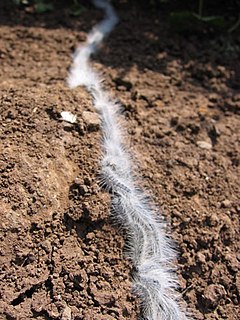
The Noctuidae, commonly known as owlet moths, cutworms or armyworms, are a family of moths. They are considered the most controversial family in the superfamily Noctuoidea because many of the clades are constantly changing, along with the other families of the Noctuoidea. It was considered the largest family in Lepidoptera for a long time, but after regrouping Lymantriinae, Catocalinae and Calpinae within the family Erebidae, the latter holds this title now. Currently, Noctuidae is the second largest family in Noctuoidea, with about 1,089 genera and 11,772 species. This classification is still contingent, as more changes continue to appear between Noctuidae and Erebidae.

The Arctiinae are a large and diverse subfamily of moths with around 11,000 species found all over the world, including 6,000 neotropical species. This subfamily includes the groups commonly known as tiger moths, which usually have bright colours, footmen, which are usually much drabber, lichen moths, and wasp moths. Many species have "hairy" caterpillars that are popularly known as woolly bears or woolly worms. The scientific name Arctiinae refers to this hairiness. Some species within the Arctiinae have the word "tussock"' in their common names because they have been misidentified as members of the Lymantriinae subfamily based on the characteristics of the larvae.

Oenosandridae is a family of Australian noctuoid moths. Genera include:

Notodontidae is a family of moths with approximately 3,800 known species. The family was described by James Francis Stephens in 1829. Moths of this family are found in all parts of the world, but they are most concentrated in tropical areas, especially in the New World.

Noctuoidea is the superfamily of noctuid or "owlet" moths, and has more than 70,000 described species, the largest number of for any Lepidopteran superfamily. Its classification has not yet reached a satisfactory or stable state. Since the end of the 20th century, increasing availability of molecular phylogenetic data for this hugely successful radiation has led to several competing proposals for a taxonomic arrangement that correctly represents the relationships between the major lineages.

The rough prominent is a moth of the family Notodontidae, subfamily Phalerinae. It is also known as the white-dotted prominent and the tawny prominent. The species was first described by James Edward Smith in 1797. This common moth is found across North America from the northern boreal forests to as far south as Florida. It is most common in deciduous forests at some elevation. It is nocturnal but attracted to lights. The moths start to fly soon after dusk and return to resting places some time before dawn breaks. The adults live through late spring and early summer, and larvae are active until fall. They then pupate until the following spring.

Thaumetopoeinae is a subfamily of moths in the family Notodontidae. This group is sometimes treated as a family Thaumetopoeidae with three subfamilies: Thaumetopoeinae, Anaphinae and Epicominae. However, it is now commonly treated at subfamily rank based on morphological and molecular phylogenetic evidence.

Notodontinae is the nominate subfamily of the moth family Notodontidae. The Ptilodoninae are sometimes merged herein. The genus list is preliminary, as not all Notodontidae have been assigned to subfamilies yet.

Pygaerinae is a subfamily of the moth family Notodontidae, the silver prominents and relatives. The genus list is preliminary, as not all Notodontidae have been assigned to subfamilies yet.
Platychasmatinae is a small East Asian subfamily of the moth family Notodontidae. Only two genera are placed here at present:

Thaumetopoea solitaria is a moth of the subfamily Thaumetopoeinae in the family Notodontidae first described by Christian Friedrich Freyer in 1838. It is found in Anatolia, on Cyprus, east to Syria, Israel, Lebanon, Iraq and Iran.

Dioptinae is a subfamily of the moth family Notodontidae.

The Erebidae are a family of moths in the superfamily Noctuoidea. The family is among the largest families of moths by species count and contains a wide variety of well-known macromoth groups. The family includes the underwings (Catocala); litter moths (Herminiinae); tiger, lichen, and wasp moths (Arctiinae); tussock moths (Lymantriinae), including the arctic woolly bear moth ; piercing moths ; micronoctuoid moths (Micronoctuini); snout moths (Hypeninae); and zales, though many of these common names can also refer to moths outside the Erebidae. Some of the erebid moths are called owlets.
Chrysoglossa maxima is a moth of the family Notodontidae first described by Herbert Druce in 1897. It is found in Panama, Costa Rica and Guatemala.
"Scoturopsis" seitzi is a moth of the family Notodontidae first described by Hering in 1925. It is found in Bolivia.
Euchlaenidia albilinea is a moth of the family Erebidae first described by Schaus in 1912. It is found in Costa Rica.
Nystaleinae is a subfamily of the moth family Notodontidae. The subfamily was described by William Trowbridge Merrifield Forbes in 1948.

Heterocampinae is a subfamily of prominent moths in the family Notodontidae. There are at least 60 described species of Heterocampinae in North America.
Pterocypha defensata is a species of geometrid moth in the family Geometridae. It is found in the Caribbean Sea and North America.
This page is based on this
Wikipedia article Text is available under the
CC BY-SA 4.0 license; additional terms may apply.
Images, videos and audio are available under their respective licenses.













